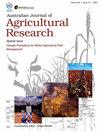Studies on ovine infertility in agricultural regions of Western Australia: cervical mucus production by fertile and infertile ewes.
引用次数: 9
Abstract
As part of a study on ovine infertility in agricultural regions of Western Australia, the production of cervical mucus in fertile and infertile ewes was examined between February and July 1970. In the first test, 15 Corriedal ewes (5-6 years old) were implanted with Silastic implants containing 375 mg of progesterone for a period of 16 days to synchronize the onset of estrus. All ewes grazed on nonestrogenic pastures or were hand-fed grain during the test period. During a second 16-day study, ewes were injected intramuscularly daily with 10 mg progesterone in 1 ml of oil. 48 hours after the last progesterone injection, ewes were injected with estradiol benzoate in 1 ml of oil. After both tests, mucus samples were collected on cylindrical cotton swabs at 6-hour intervals. The first progesterone test revealed a significant (p less than .05) difference in the total weight of mucus between fertile (23.3 g) and infertile (34.6 g) ewes. After the second progesterone treatment, fertile ewes again produced significantly less mucus than the infertile ewes (25.7 vs. 37.2 g; p less than .05). Production of mucus in infertile ewes was 1.5% greater than that produced by fertile ewes at both a synchronized and a natural estrus. Both groups of ewes showed similar responses to exogenous estrogen following ovariectomy. Data indicated that the increase in the total weight of mucus is due to an increase in fluid content. As the rheological properties of cervical mucus contribute to sperm transport, production of a thinner watery mucus in ewes may account for infertility.西澳大利亚农业地区绵羊不孕症的研究:可育和不育母羊的宫颈粘液生产。
本文章由计算机程序翻译,如有差异,请以英文原文为准。
求助全文
约1分钟内获得全文
求助全文

 求助内容:
求助内容: 应助结果提醒方式:
应助结果提醒方式:


